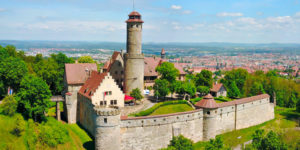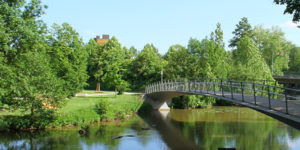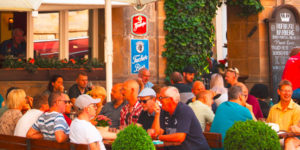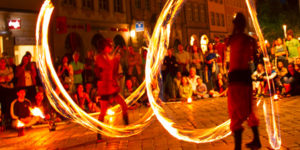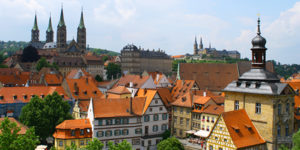Otto of Bamberg
The Bishop of Bamberg, Bishop Otto, was a great supporter of the monastery. He was a missionary and, as bishop of Bamberg, was regarded as an important mediator between emperor and pope. After his death, in 1139, he was buried in the church of the monastery and canonized from the Pope in Würzburg in 1189. The monastery St. Michael received in this course the personal protection of the pope and with it an unusual status.
In the 13th century the monastery developed more and more a certain independence from the Bamberg bishop’s chair. The economic basis for this was the enormous property, which was distributed in 441 places over the entire diocese.
Decay of the Monastery
In the 15th century the monastery was plundered due to a dispute with the citizens and also the Peasant War, as well as the Thirty Years’ War hit the monastery enormously. Plunderings, failed reform attempts and last but not least the disputes over immunity led to debt and the creeping decline of the monastery.
The monastery only experienced a renaissance in the 17th and 18th centuries when, after two fires, the monastery and its church were rebuilt. Leonard and Johann Dientzenhofer, who as the most esteemed architects of their time were also responsible for the construction of the monastery church of Banz, had the direction of the reconstruction.
At the beginning of secularization, in the 19th century, the monastery still had plenty of land. But during the years the Bavarian troops plundered many precious objects of the monastery. Many books were taken from the monastery library and brought to the Bavarian Court library in Munich.
In 1803, the monastery became property of the City of Bamberg, which used the space to build hospitals. The Bürgerspital still exists today.
The Church
The original church inside the monastery property collapsed in 1117, probably because of an earthquake having the epicenter in the northern of Italy. The new church was built in Romanesque style and consecrated in 1121.
In the 17th century two fires in the church irreparably ruined the nave and the west building. Both parts of the building had to be completely renovated, which was to lead to subsequent structural problems about 350 years later.
After the second fire the organ was built, which has survived until today: a precious work of the late Renaissance. The baroque exterior of the church was built in the 17th century by Leonhard, the terrace and the convent building are a work of Johann Dientzenhofer.
In the 19th century, the tombstones of the Bamberg bishops were transferred from the cathedral to the monastery church. This was on the instructions of King Ludwig I, who after the cathedral’s fundamental restoration considered the monuments to be out of style.
Magnificent interiors – not to visit until 2021!
Due to massive, static structural defects, the former monastery church of St. Michael in Bamberg has not been open to visitors since 2012. Originally, the church was to be accessible again in November 2021, on the 1000th anniversary of the consecration of St. Michael. However, this date cannot be kept due to the extensive renovation measures and is being postponed. Now in the year 2025 the monastery should shine again in old splendour.
Particularly impressive are the interiors of the church, the design of the choral altar and most of all the splendid paintings on the ceiling, completed by four painters in 1617, which portray a rich herbarium. The paintings represent as many as 600 different species of plants, including exotic fruits such as pineapple and pomegranates, cotton plants or tobacco. Therefore, the ceiling paintings of the monastery church are often referred to as “herb garden” or “sky garden”, depicting flora in its most diverse and beautiful form. Particularly noteworthy is the fact that plants can be seen which only became native to Germany in the 16th century, such as lilac, jasmine or golden rain, which reached Bamberg via the Dutch naturalist Carolus Clusius.
Most of the plants are blooming or bearing fruits. Not shown are mushrooms or crops. It is believed that the arrangement of the plants goes back to Albertus Magnus, in whose observations mushrooms played no role. In the transept, the paintings mainly depict trees and shrubs, while in the central nave fruit varieties and flowers are depicted in the side naves.
In the 18th century further elements were added later in the side naves, on which several species of birds, including parrots, can be seen. These represent a certain stylistic break, since they are the only animals in the entire ceiling.

